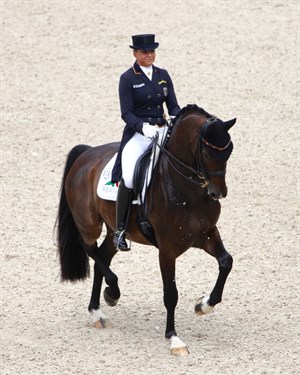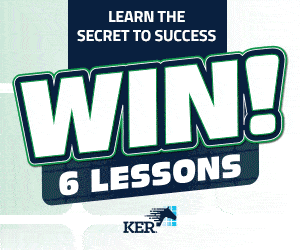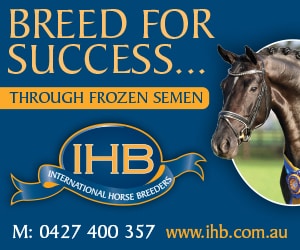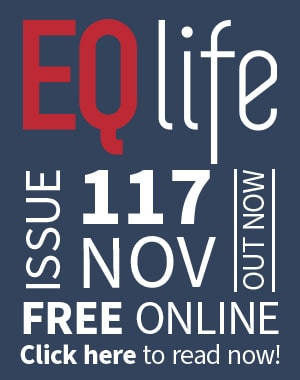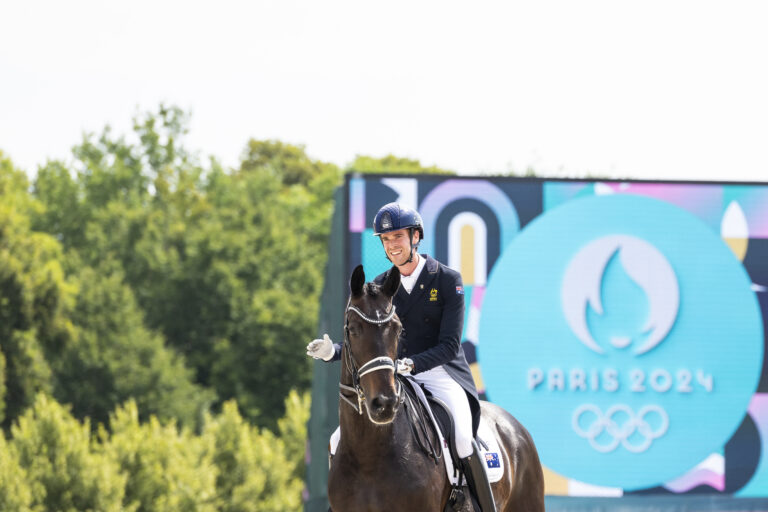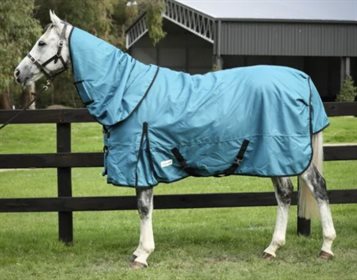This article has appeared previously with Equestrian Life. To see what’s in the current issue, please click here.
Dorothee Schneider and Showtime demonstrate picture perfect collection and engagement in the demanding piaffe.
© Roger Fitzhardinge
BY KERRY MACK
For those who are not dressage enthusiasts, watching dressage might seem pretty dull unless you understand the jargon, the buzzwords for what the judges are looking for. Sometimes the prettiest horse doesn’t score the best. It’s not the fastest test that wins. It can be hard to understand how the judges decide who wins. At EQ Life we thought you might like to know more about the principles that underpin judging. These principles underpin training as well. So if you have been watching the Olympic dressage, including eventing dressage, you can look for these qualities and better assess the quality of the performances. It should make watching the dressage more interesting. And if you are a rider, these are also the key principles to underpin training your horse.
The definition of dressage that I use is “training the horse to improve balance, suppleness, and obedience”. Of course, this is relevant to all riders, not just those of us who participate in dressage competitions. The training of the horse is the most interesting part of riding. No matter how much you know you can always learn more and improve as a trainer. That’s one of the reasons horse riding becomes an obsession to many of us. If you are going to ride your horse, you may as well spend the time training him and improving him. As renowned showjumping coach George Morris says: “A well-trained horse has a better life. The kindest thing you can do for your horse is train him well.”
The Germans have taken a systematic approach to teaching how to train. They developed the six-point training scale to give guidance to trainers as to the qualities to be instilled in the horse.
RHYTHM, SUPPLENESS, CONTACT, STRAIGHTNESS, IMPULSION, COLLECTION
These are the buzzwords. The training scale probably first appeared in the German Cavalry manual in 1912. The point was to have a standardised approach to training across a large cavalry force to assist the less experienced cavaliers to train their own horses. It developed into its modern form by 1937. Controversial French trainer Francois Baucher had also developed a training scale in the late 1800s. Not surprisingly, his started with “lightness”, followed by “obedience”, “straightness”, “self-carriage”, and “collection”. The French school still differs from the German school by its emphasis on lightness.
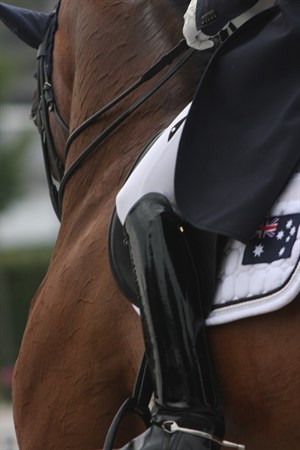
A meaningful contact is paramount, as demonstrated by Maree Tomkinson and Diamantina.
© Roger Fitzhardinge
It is very important to understand that the training scale is not a linear scale. It is a set of qualities or principles that define good training. You don’t achieve one quality, then another, in a linear progression. Rather, you keep these qualities in mind and build them as you train. You check that as, for example, you add more “impulsion” that the qualities that are listed before are also maintained, eg, that “rhythm” and “suppleness” and the “contact” can all stay the same. If you lose the “rhythm” as you increase “impulsion”, if the horse rushes and speeds up the tempo, you must re-establish the “rhythm” and ask again until the horse finds a way to increase “impulsion” whilst keeping the rhythm the same. We tend to see “rhythm”, “suppleness” and “contact” grouped together in the foundation training. “Straightness”, “impulsion” and “collection” are likely to be the focus later on when developing thrust and carrying capacity of the horse. The later stages are when the horse is learning to bend his hindleg more, place the hindleg further under the body and carry weight. This becomes the natural progression as training proceeds with collected exercises such as shoulder-in, pirouettes, all the way to the tempi changes and the piaffe and passage, which, of course, require the greatest carrying capacity of the movements in the tests.
The training scale is often illustrated as a pyramid with a base of “rhythm” and a pinnacle of “collection”. (The words used to translate from the German can vary as some do not have a direct English translation.)
RHYTHM refers to regularity of tempo, a steady and consistent rhythm with true gaits. Four-beat walk, two-beat trot, canter with three beats and a moment of suspension. The tempo (speed of the beats) may vary but rhythm must remain true. Each step is the same. The correct tempo will usually be the speed of the steps that allows each step to swing forward to be as long as possible.
SUPPLENESS is both elasticity and relaxation (physical and mental) including lateral and longitudinal suppleness (side to side and over the back). Suppleness comes from stretching muscles, rather than making muscles short and tight. Of course, relaxation is a prerequisite for true suppleness.
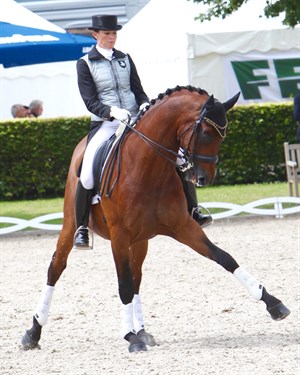
Lyndal Oatley and Sandro Boy are the epitome of suppleness. Take note!
© Roger Fitzhradinge
CONTACT refers to the acceptance of the bit and the rider’s aids. The horse should reach forward into the bridle and the rider should likewise reach forwards towards the mouth, not pulling back. Pulling back with the rein will make a short neck. The contact should be stable, even and light.
IMPULSION is the increasing energy from the hindleg.
STRAIGHTNESS is when the front legs are in line with the hindquarters. Of course, the shoulders are more narrow than the quarters, so in canter the inside front leg should be in line with the inside hindleg. Horses will have a naturally more concave side (usually the right) and a more convex side (usually the left). He may bend easily to the right but on the left rein you may find yourself pulling the left rein to keep trying to bend him. Sometimes this will make him bend like a banana. Good training will make him more symmetrical and he will find it easier to be straight.
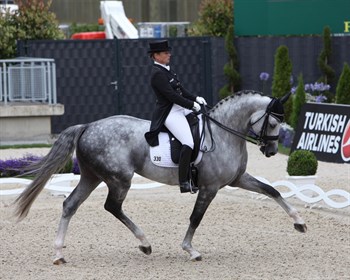
Isabell Werth and DSP Belantis demonstrate that straightness is imperative on both straight and curved lines.
© Roger Fitzhardinge
COLLECTION is the increasing engagement and the ability to balance on the hindlegs. The steps will become higher and shorter. The energy, the rhythm etc all remain.
So, when you are training a potential Olympic horse (or your horse intended for any other future), these are the principles to keep in mind, whether you are training a walk to trot transition, or piaffe to passage transitions, or a simple change of leg at canter, or a row of one-time changes.
And these qualities are what judges look for to evaluate the quality of every movement, whether it’s the entry and halt or the pirouettes.
The judges also look for how well the horse fulfills the technical requirements of each movement. For example, the canter pirouettes should be in a true canter rhythm, with a regular tempo, with sufficient bending through the body. The horse must be supple and relaxed, the steps energetic. The entry into the pirouette must be straight. The pirouette at canter, like the piaffe in trot, will show the highest degree of collection. The horse must show a great capacity to balance on the hindleg. This is the highest degree of engagement and collection required in competition dressage. These movements are worth twice as much as the less collected movements. In fact, currently nearly a third of the marks in the Grand Prix test are for the piaffe and passage.
If you are interested you will find the requirements for each movement on the FEI website. You can also find directives to judges on assessing the degree of difficulty of the movements of the freestyle test and you will find watching dressage much more interesting if you check this out.
So sit back and enjoy. See if you can get your eye in to see what the judges see.
READ THE LATEST NEWS ARTICLES HERE

